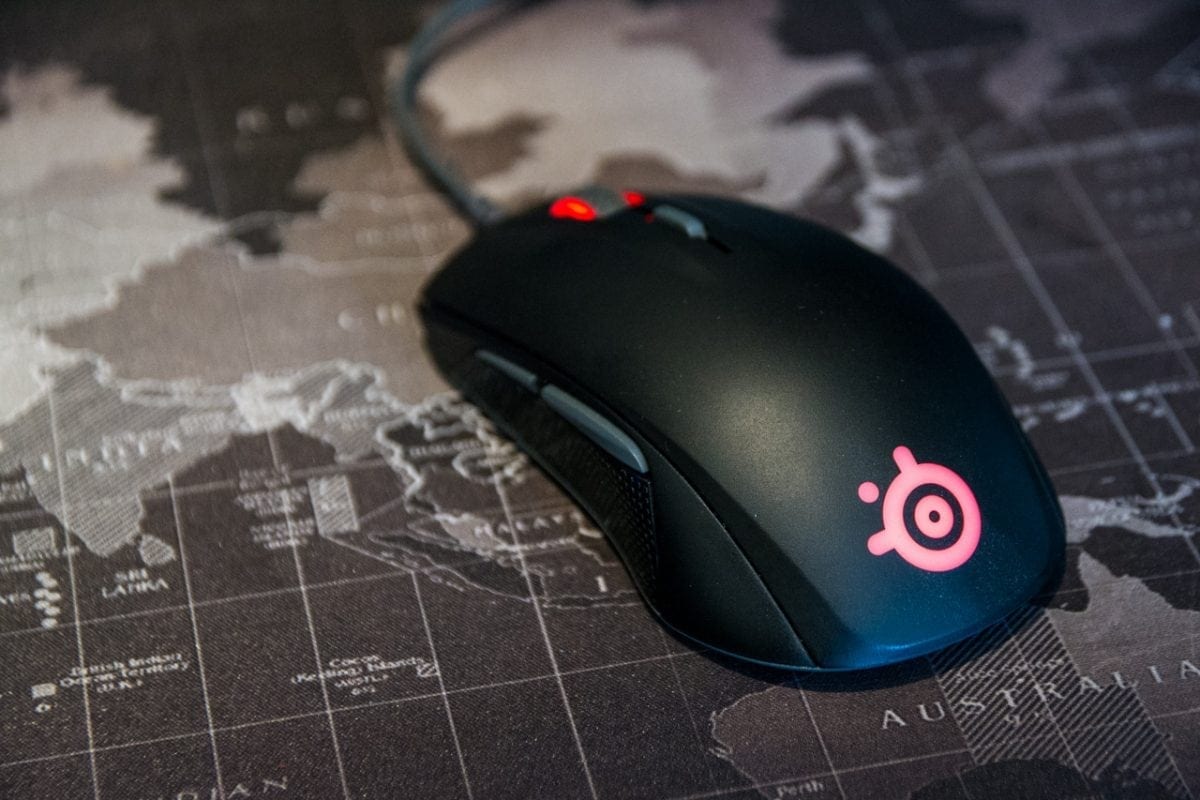- Inexpensive gaming mouse
- Comfortable fit
- RGB LEDs for lighting customization
- Only 6 buttons
- Smaller than other gaming mice
When it comes to mice in general and gaming mice in particular, what do you look for? What is your typical budget? Gaming mice can range from really inexpensive to wow, I may not eat this week. But what if you could get a good gaming mouse without having to sacrifice the next week’s worth of food? The SteelSeries Rival 110 will not break your bank and it will not disappoint you in the field of battle either.
The SteelSeries Rival 110 is a TrueMove optical sensor-based mouse with True 1-to-1 tracking, an upgrade from their previous Rival 100 gaming mouse.
Features and Specifications
- SteelSeries TrueMove1 Optical Sensor
- 200-7200, in 100 CPI increments
- IPS of 240
- 30g of acceleration
- 1ms polling
- Universal Ergonomic design
- All Grip styles (Palm, Grip, Claw)
- 6 Buttons
- 30M clicks
- RGB illumination
- 87.5 grams | 31 ounces
What’s in the Box?
The contents of the SteelSeries Rival 110 box are quite minimal. You get the Rival 110 gaming mouse and the product information pamphlet. Nothing else is needed!
First Impressions
SteelSeries has kept to a simple design with the Rival 110. It looks like the previous Rival 100 but with updated insides. It is universal in shape and is designed in a way that will work no matter how you grip a mouse. Yes, different people grip mice differently.
The SteelSeries Rival 110 is smaller than other gaming mice I have used and I have found that I’m using more of a finger-tip grip with it, but your mileage will vary based on the size of your hand and your grip style.
When you look closer at the Rival 110, you will see the CPI button behind the textured scroll wheel. A split in the top plastic provides the left and right mouse buttons, which have a 30 million click life. The left side or thumb side has the forward and back buttons, which are programmable to your liking. I did find in my tests that I accidentally would hit the back button from time to time.
The profile is is fairly normal and the grips are textured to help you keep a hold of the mouse. The rear or back of the mouse displays the RGB-capable illuminated SteelSeries logo.
Flip the mouse over to look at the bottom and you can see the optical sensor area and the 3 TFPE feet which all have been slightly increased over the previous Rival model. The larger TFPE feet allow for a smoother and easier movement over surfaces.
Setup
The SteelSeries Rival 110 is a plug and play mouse. You plug it in and the OS recognizes it right away and loads the appropriate driver (at least for Windows 10). To configure the mouse, you will need to install the SteelSeries Engine software. Out of the box, chances are you will need to update the firmware of the Rival 110 like I was prompted to do, but it is a quick and easy process.
With the SteelSeries Engine software, you can specify the two CPI settings for the Rival 110, reprogram the buttons and change the colour and pattern of the LEDs.
Speaking of the LED colours, you can really customize them. There are only two areas that light up on the SteelSeries Rival 110 and that is the logo at the back and the area either side of the scroll wheel. You do have the options of Steady, ColorShift, Multi-Color Breathe, Single Color Breathe and, of course, off. Depending on your setup, I know I like to either make use of Steady or ColorShift.
Performance
For a gaming mouse at the entry-level price range, it operates quite well. If you want to slow the mouse down, the SteelSeries Rival 110 can go down to a CPI of 200. Note that SteelSeries is one of the companies that actually use the term CPI or Counts Per Inch, as opposed to other companies that may state the mouse sensitivity in DPI or Dots Per Inch (which is technically a print/display term).
Either way, 200 at the low end is great for attempting headshots where you don’t want a jerky movement to throw you off your game, but when you need to, you can push the CPI up to 7,200.
The larger TPFE feet are great for gliding across surfaces, but I find that it is best to make use of a mouse pad or mouse mat. Eventually, the TPFE feet will wear out, but not for a while, and you will probably end up buying a new mouse at that point anyway.
The general use of the mouse has been good. It has been good for daily tasks and it has been good when diving into a game of Fortnight here and there. The mouse button clicks are properly registered, the scroll wheel is a nice width and has good movement. The two side buttons are easily accessible and can be programmed away from their defaults of page navigation.
Final Thoughts
The SteelSeries Rival 110 Gaming Mouse is targeted towards budget-conscious gamers. If you are on a budget but don’t want to sacrifice mouse performance, the SteelSeries Rival 110 fits that bill. It can also be customized to fit your lighting preferences too.
The SteelSeries Engine allows you to easily configure the 6 available buttons as well as change the mouse’s RGB lighting scheme. Profile selection may be a little lack-luster but you can toggle between two CPI settings easily enough when you need to.
If you are looking for a entry-level gaming mouse or you are on a fairly tight budget, I would recommend looking into the SteelSeries Rival 110. It’s available now for about $30.

